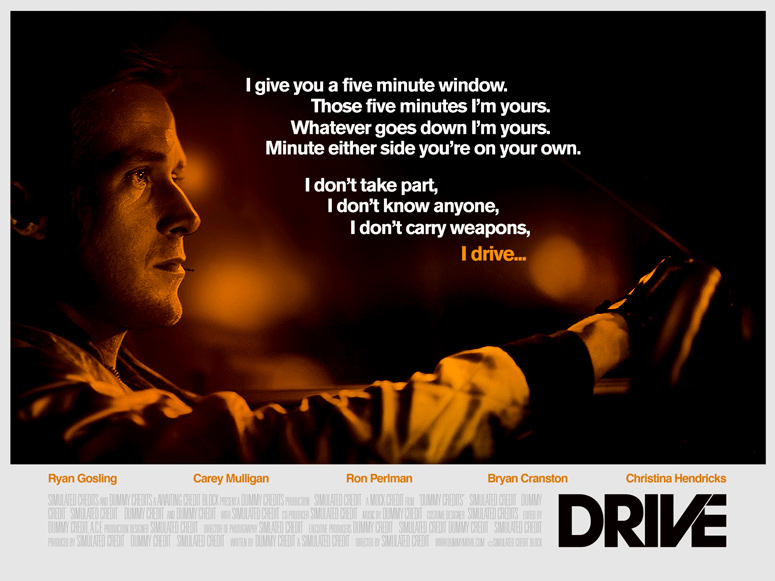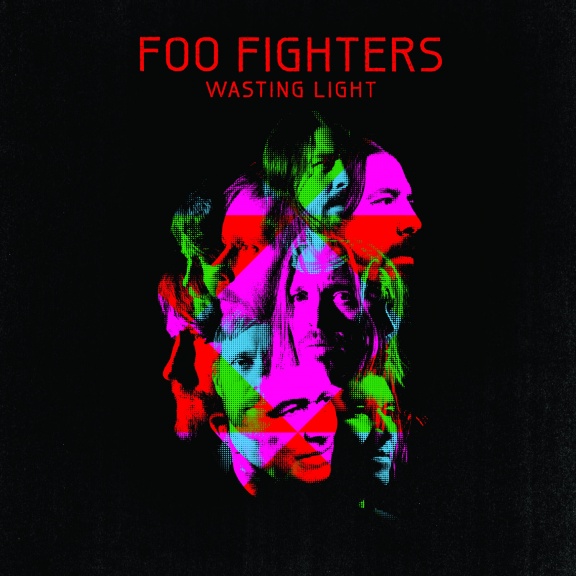Last updated on March 4, 2013
It’s been an interesting week! Join me for a movie and an album!
Drive – Contrary to this alternative poster art, the Driver doesn’t do a lot of driving in the film. That’s his profession more than anything else; a stunt driver by day and a mercenary driver for hire by night, he speaks little and lets his actions speak for themselves. In fact, it wouldn’t be far from the truth to say that he’s a force of nature more than a person. It’s almost as if he’s a Steve McQueen-style character come to life, solely defined by what he does. One day, according to a character in the film, he just popped out of the blue and asked for a job as a mechanic, and he’s been doing the same thing ever since.
It’s when the Kid/Driver makes some human emotional connection to someone else, our female lead, that things go awry and bad luck comes his way. It’s by deviating from his path of the straighfoward and withdrawn life that he must come into conflict. It’ll take some violent beatings and a wary eye to claw his way out and to save that woman and himself from death. It’s weirdly reminscent of Max Payne, except every person simply became a victim of circumstance, from low-end crime boss to a (newly) single mother of one.
I’m trying my best to be as vague as possible – explaining plot details in a film like this really doesn’t help convey why Drive works. It’s a derivative plot, sure, and there’s barely any dialogue, but Drive’s intent isn’t to wow you with a complex set piece. Rather, Drive establishes a specific mood and feeling onto a stereotypical framework. Almost like a fusion of ’80s pop synth and ’70s grindhouse, Nicolas Winding Refn creates an atmosphere of comfort, tension, and foreboding all at once. This unbearable tension eventually culminates in scenes of intense violence, at times darkly comic and at times disturbing in equal measure. The movie isn’t as excessively violent as many have said, but the selective nature of when and where that violence occurs gives it much greater impact that it would have in any generic thriller of the past twenty years.
It’s not purely a movie of style, either; the entire first half of this 100 minute adventure contains a slow build with lots of dialogue, music, and staring. You get a feel for the past lives of these people and get tiny inklings of what makes them who they are without having to provide a long and convoluted backstory. That’s a difficult technique to employ, especially in relying on an audience to pay attention. Refn does this beautifully; the imagery, the cinematography, and the music all provide additional context to what’s happening. It even makes a drive from a crime scene with zero chases incredibly exciting and suspenseful. The characters don’t have to define themselves through excessive monologues, solliquoys, or dialogues; they just are.
Or, you might say, Drive remains an ultimate expression of that old story-telling advice: show, don’t tell. Drive shows plenty, I assure you. Albert Brooks pulls in a sterling and uncharacteristic performance, and Gosling’s removed demeanor fits perfectly in the tone.
Foo Fighters: Wasting Light – I’d call myself a “rock and roll” fan. I’ve got more CDs than I care to share on the Internet of all different subgenres, from the lightest of the light to the heaviest of the heavy. Most of my listening tastes outside of video game music strays between metal and hard rock, with a little garage for flavor. When I tell you I have experience with these things, I’m not making it up. An album can be superb, or bad, but there’s one thing worse.
Wasting Light by the Foo Fighters commits the worst crime: it’s simply mediocre. And mediocre means forgetable, which is NOT what I want to get from the Foo Fighters.
Sure, it won a Grammy (not that anyone cares about who wins the Grammies, but still), but it’s not that good. Dave Grohl, originally the drummer of Nirvana until Kurt Cobain’s untimely death, has a great gig with Foo Fighters; it’s pure hard rock, and he has a pretty good voice. He’s also an excellent songwriter, and that greatest hits album was well-deserved considering the success they’ve had. 1997’s The Color and the Shape remains a standard for late 1990s stadium rock (and Everlong), and 2005’s double album In Your Honor shows the diverse range of which this group is capable with its acoustic and rock music split across twenty tracks. I even like 2002’s One, which has my favorite Foo Fighters song on it, All My Life. Take a listen:
That typifies their sound, with catchy riffs and straightforward choruses. It’s not complex, but it doesn’t have to be.
Over the years, however, it’s become difficult to see how Foo Fighters can “expand” their sound. They’re distinctive, sure, but you can’t just keep writing the same riffs and repeating the same cryptic lyrics over and over again. That’s why Grohl took a break at several times, once to be the temporary drummer for Queens of the Stone Age on Song for the Deaf (such an excellent record it’s not even funny) and in the rock supergroup Them Crooked Vultures with John Paul Jones of Led Zeppelin fame and Josh Homme, frontman for QOTSA (basically a Queens record with more complex guitar works and a lot more jamming). The former led to 2005’s In Your Honor, and the first disc takes the hard rock elements to the next level and shoots them to the moon. It’s intense and wonderful, and they try all different kinds of rock music on there.
It’s just that Wasting Light does little to nothing to improving or maturing the band’s sound in any way. Cribbing the “vocal style” of Dave Oliveri, former bassist for QOTSA, for one darn song does not innovation make (“White Limo”, you’re guilty). I saw so many critics laud this as a “return to form”, but I’m not buying it. It’s almost as low key as In Your Honor’s second acoustic disc, even though it’s got a full rock band behind it. There’s just no force or inspiration behind it at all; it’s by the numbers, and it shows.
Any Foo record has a great opener; “Bridges Burning” excels as always in highlighting the tone of a Foo Fighters Record, but here it doesn’t perform that duty at all because everything else doesn’t live up to the opener. After that, the album slumps into normal Foo Fighters tropes without the catchy riffs. “Rope” and ” “Walk” go through the motions without a hook to their name. Pitchfork Media was definitely right – they just don’t make them like they used to do it. I’m not judging the album by its catchiness, but by its lack of differentiation. Heck, if I want a Foo Fighters album, why not listen to the earlier ones? There just isn’t the same speed and vigor that The Color and the Shape has, or even 2007’s Echoes, Silence, Patience and Grace. “Walk” is the only other song with that kind of inspiration and energy that most Foo Fighter songs represent; everything else tries to duplicate the sound, but fails.
Time to take another vacation, Grohl, perhaps a permanent one with Them Crooked Vultures. Time to hang up the hat and walk out of a seventeen year lucrative career (like that’ll happen).
———————————————————————————————————————————————————————————————————————–
That’s it for today’s Monday Update! Stay tuned for some weird stuff.


